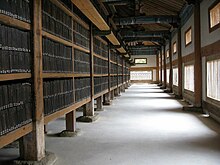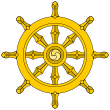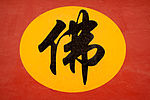
Back চৈনিক বৌদ্ধ আনুশাসনিক ধর্মগ্রন্থ Bengali/Bangla Chinese Buddhist canon English Dazangjing French चीनी बौद्ध साहित्य Hindi Kínai buddhista kánon Hungarian Canone buddista cinese Italian 대장경 Korean चिनी बौद्ध त्रिपिटक Marathi Den kinesiske buddhistiske kanon NB Cânone budista chinês Portuguese


| Bagian dari seri tentang |
| Buddhisme |
|---|
 |
| Bagian dari seri mengenai |
| Buddhisme Han 汉传佛教 / 漢傳佛教 |
|---|
 |
| Bagian dari seri tentang |
| Buddhisme Mahāyāna |
|---|
 |
Tripitaka Tionghoa atau Kanon Buddhis Tionghoa, juga dikenal sebagai Tripitaka Cina atau Kanon Buddhis Cina, merujuk pada keseluruhan literatur Buddhis berbahasa Tionghoa yang dianggap kanonis dalam Buddhisme Tionghoa di Tiongkok, Jepang, Korea, dan Vietnam.[1][2][3] Sebutan tradisional untuk kitab ini adalah "Penyimpanan Kitab Suci yang Besar" (Hanzi Tradisional: 大藏經; Hanzi Sederhana: 大藏经; Pinyin: Dàzàngjīng; bahasa Jepang: 大蔵経; Rōmaji: Daizōkyō; bahasa Korea: 대장경; Romaja: Daejanggyeong; bahasa Vietnam: Đại tạng kinh).[4]
Konsep Tripitaka Tionghoa dipengaruhi oleh konsep Tripitaka pada aliran Buddhis di India, yang secara harfiah berarti 'tiga keranjang'—Sutta, Vinaya, dan Abhidhamma. Namun, umat Buddhisme Tionghoa secara historis tidak memiliki akses terhadap Tripitaka versi Buddhisme India.[5] Akhirnya, teks-teks individual dibawa ke Tiongkok secara individu atau dalam jumlah kecil dan diterjemahkan satu per satu. Hal ini menyebabkan terciptanya versi Tripitaka Tionghoa atau Kanon Buddhis Tionghoa yang strukturnya berbeda.[6]
- ^ Han, Yongun; Yi, Yeongjae; Gwon, Sangro (2017). Tracts on the Modern Reformation of Korean Buddhism. Jogye Order of Korean Buddhism (dipublikasikan tanggal September 20, 2017).
- ^ Storch, Tanya (2014). The History of Chinese Buddhist Bibliography: Censorship and Transformation. Cambria Press (dipublikasikan tanggal March 25, 2014).
- ^ Jiang Wu, "The Chinese Buddhist Canon" in The Wiley Blackwell Companion to East and Inner Asian Buddhism, p. 299, Wiley-Blackwell (2014).
- ^ Jiang Wu, "The Chinese Buddhist Canon" in The Wiley Blackwell Companion to East and Inner Asian Buddhism, p. 299, Wiley-Blackwell (2014).
- ^ Jiang Wu, "The Chinese Buddhist Canon through the Ages: Essential Categories and Critical Issues in the Study of a Textual Tradition" in Spreading Buddha's word in East Asia: the formation and transformation of the Chinese Buddhist canon, p. 23, ed. Jiang Wu and Lucille Chia, New York: Columbia University Press (2015)
- ^ Lancaster, Lewis, "The Movement of Buddhist Texts from India to China and the Construction of the Chinese Buddhist Canon", pp. 226-227, in Buddhism Across Boundaries--Chinese Buddhism and the Western Regions, ed. John R McRae and Jan Nattier, Sino-Platonic Papers 222, Philadelphia, PA: Department of East Asian Languages and Civilizations, University of Pennsylvania (2012)